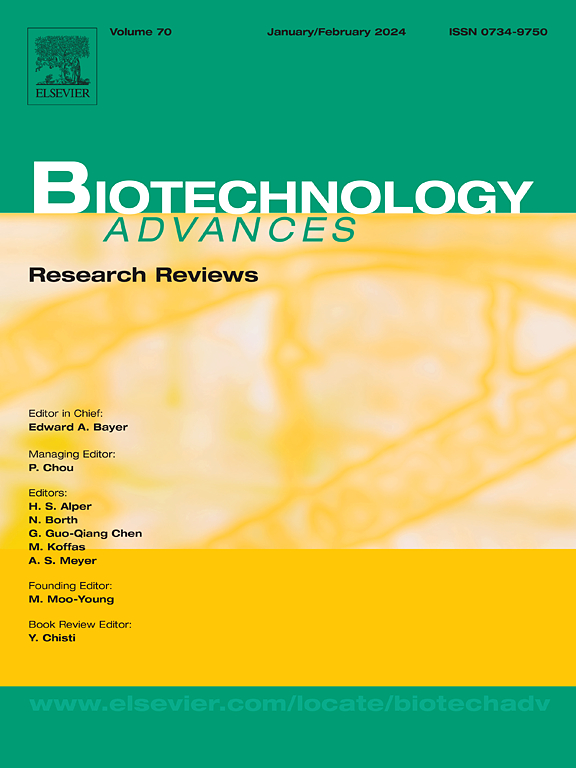Bioactive metabolites and extracellular vesicles from the marine chlorophyte genus Tetraselmis: Review
IF 12.5
1区 工程技术
Q1 BIOTECHNOLOGY & APPLIED MICROBIOLOGY
引用次数: 0
Abstract
Microalgal biotechnology offers sustainable applications that align with the principles of the circular bioeconomy, providing innovative and resource-efficient solutions to help achieve the United Nations' Sustainable Development Goals. Within this framework, the marine chlorophyte genus Tetraselmis is attracting increasing attention for its potential in biotechnology and biomedicine. As facultative mixotrophs, Tetraselmis species exhibit metabolic flexibility and high tolerance to abiotic stresses, enabling the efficient biosynthesis of a wide range of bioactive compounds, including polyunsaturated fatty acids (PUFAs), carotenoids, tocopherols, and phenolic compounds. These compounds exhibit a broad spectrum of beneficial biological activities, such as antioxidant, anti-inflammatory, immune-modulating, antibacterial, antiviral, and anticancer properties, making Tetraselmis species valuable resources for functional foods, nutraceuticals, cosmetics, aquaculture, and pharmaceuticals. Furthermore, potential applications have been further supported by the European Union's approval of T. chuii for human consumption under the novel food regulatory framework. Additionally, extracellular vesicles (EVs) derived from T. chuii are among the most well-characterised microalgal-derived EVs. These EVs have been shown to reduce oxidative stress, modulate inflammatory pathways, and exhibit low toxicity and high biocompatibility in both human cell lines and in vivo models. Given their natural bioactive composition, these EVs offer promising potential as an innovative platform for drug delivery. This review explores the metabolic flexibility, bioactive compound production, and the therapeutic potential of Tetraselmis species and their EVs, highlighting their diverse applications in biotechnology and biomedicine. The integration of emerging interdisciplinary tools such as artificial intelligence (AI) and synthetic biology presents new opportunities to optimise cultivation strategies, enhance EV yield and functionality, and enable the engineering of strain-specific traits. These advances are expected to accelerate the development of precision Tetraselmis-based applications across biomedicine, aquaculture, and environmental sustainability, reinforcing their potential for industrial-scale adoption within next-generation biomanufacturing platforms.

海洋绿藻四足藻属的生物活性代谢物和细胞外囊泡:综述
微藻生物技术提供符合循环生物经济原则的可持续应用,提供创新和资源节约型解决方案,帮助实现联合国可持续发展目标。在这一框架下,海洋绿藻属Tetraselmis因其在生物技术和生物医学方面的潜力而日益受到关注。作为兼性混合营养体,Tetraselmis物种表现出代谢灵活性和对非生物胁迫的高耐受性,能够有效地合成多种生物活性化合物,包括多不饱和脂肪酸(PUFAs)、类胡萝卜素、生育酚和酚类化合物。这些化合物表现出广泛的有益生物活性,如抗氧化、抗炎、免疫调节、抗菌、抗病毒和抗癌特性,使四鳃鼠物种成为功能食品、营养保健品、化妆品、水产养殖和药品的宝贵资源。此外,欧盟在新的食品监管框架下批准滴虫用于人类消费,进一步支持了潜在的应用。此外,来自滴虫的细胞外囊泡(EVs)是最具特征的微藻衍生的EVs之一。在人类细胞系和体内模型中,这些ev已被证明可以减少氧化应激,调节炎症途径,并表现出低毒性和高生物相容性。鉴于其天然的生物活性成分,这些电动汽车作为一种创新的药物输送平台具有很大的潜力。本文综述了四鼠属植物及其电动汽车的代谢灵活性、生物活性化合物的产生和治疗潜力,重点介绍了它们在生物技术和生物医学方面的广泛应用。人工智能(AI)和合成生物学等新兴跨学科工具的整合为优化栽培策略、提高EV产量和功能以及实现菌株特异性性状的工程设计提供了新的机会。这些进展有望加速基于tetraselmis的精密应用在生物医学、水产养殖和环境可持续性方面的发展,并增强其在下一代生物制造平台中实现工业规模应用的潜力。
本文章由计算机程序翻译,如有差异,请以英文原文为准。
求助全文
约1分钟内获得全文
求助全文
来源期刊

Biotechnology advances
工程技术-生物工程与应用微生物
CiteScore
25.50
自引率
2.50%
发文量
167
审稿时长
37 days
期刊介绍:
Biotechnology Advances is a comprehensive review journal that covers all aspects of the multidisciplinary field of biotechnology. The journal focuses on biotechnology principles and their applications in various industries, agriculture, medicine, environmental concerns, and regulatory issues. It publishes authoritative articles that highlight current developments and future trends in the field of biotechnology. The journal invites submissions of manuscripts that are relevant and appropriate. It targets a wide audience, including scientists, engineers, students, instructors, researchers, practitioners, managers, governments, and other stakeholders in the field. Additionally, special issues are published based on selected presentations from recent relevant conferences in collaboration with the organizations hosting those conferences.
 求助内容:
求助内容: 应助结果提醒方式:
应助结果提醒方式:


